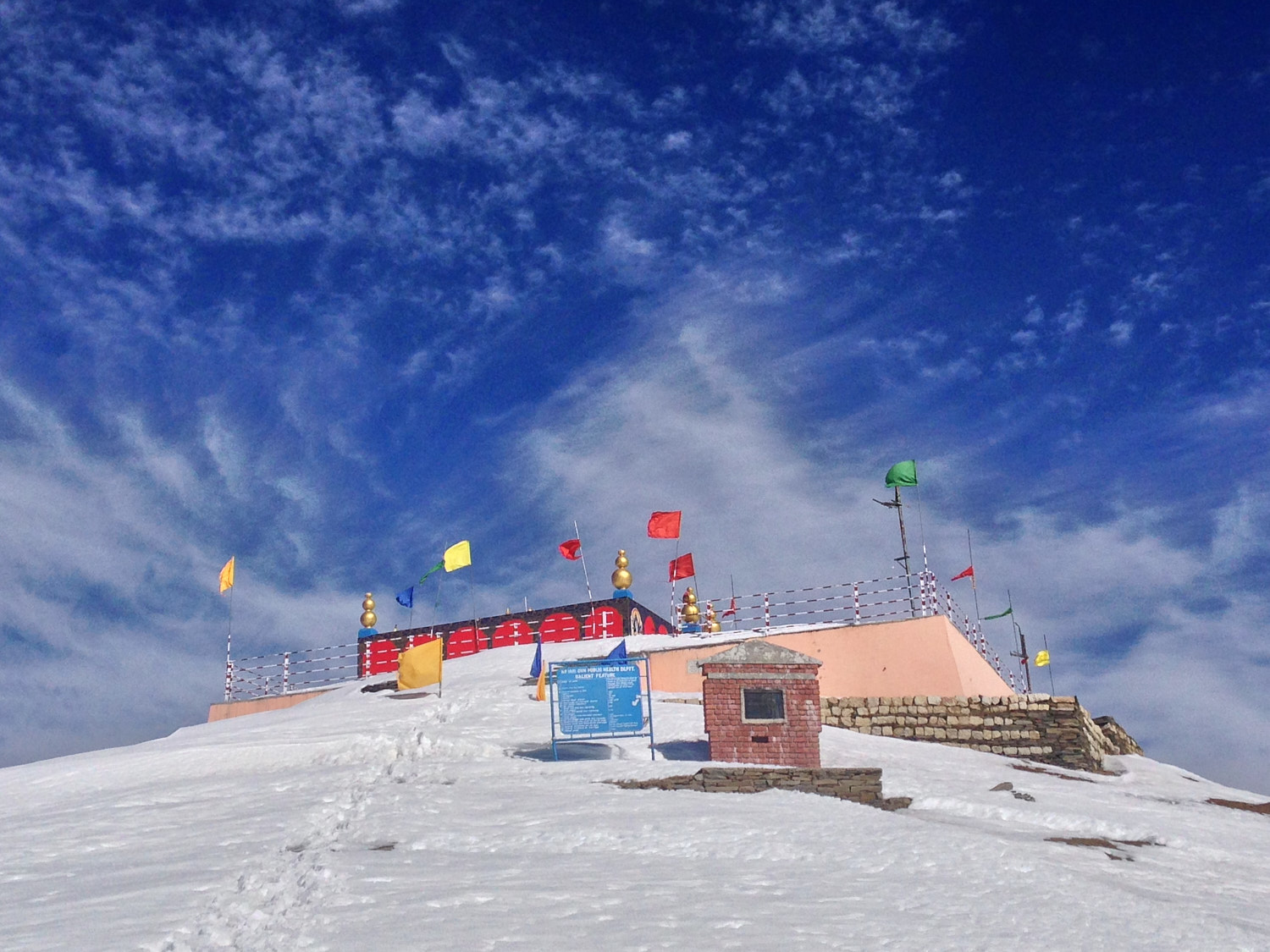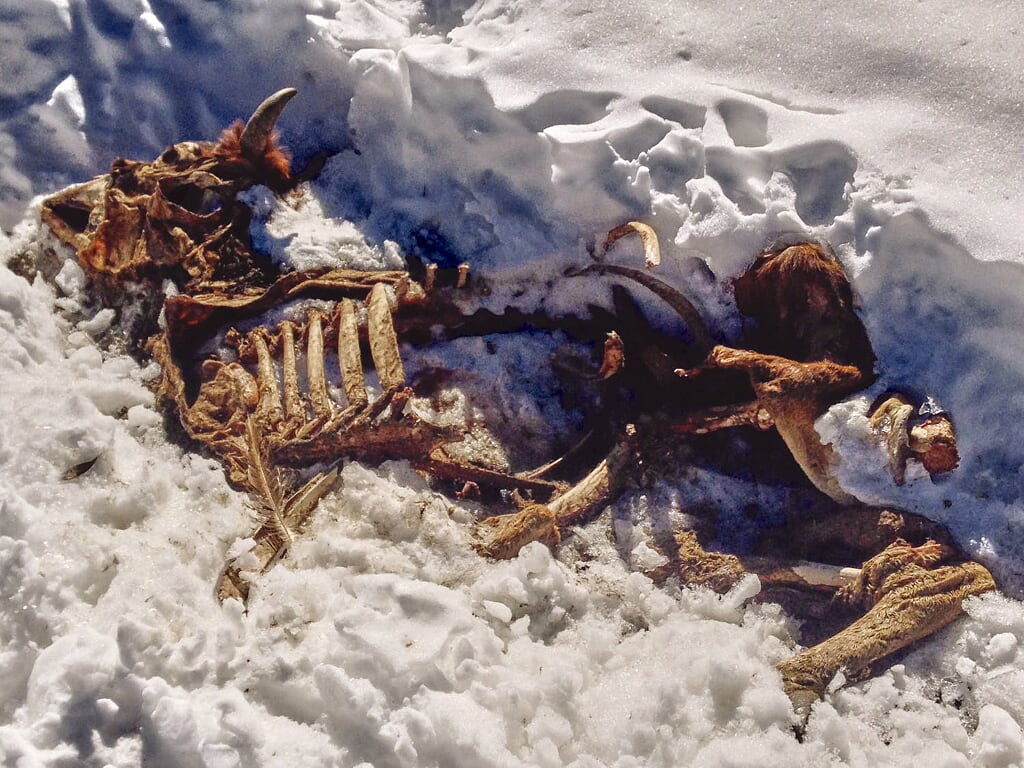Jia to Aadi Himani Chamunda Temple Trek
The Jia – Aadi Himani Chamunda is an easy 7.4-kilometre trek near Chamunda (H.P.). This trek involves a moderate yet relentless climb from Jia to the temple. Shelters, shops and solar lamps dot the trail. The trail itself is partially paved and it is clearly defined. The relatively gentle and clear trail does not involve any technical skills or any precarious drops; the temple complex provides a dormitory and bedding for an overnight stay. All these factors make this an extremely attractive trek to complete with children.
Table Of Contents
Trek Diary
Barfani Chamunda or Aadi Himani Chamunda is a Hindu temple near the town of Chamunda (Himachal Pradesh). At 2810 metres and flanked by Dhauladhars, Aadi Himani Chamunda temple is accessible via two well-defined trek routes. The more frequented trek route connects Chamunda temple with Aadi Himani Chamunda via Jadrangal. This is a route frequented by pilgrims and it is a much straighter and paved with stone steps. The other trekking route is lesser-known, but is more scenic. This route starts near Jia Village. Jia is a picturesque mountain hamlet nestled in Dhauladhar foothills. This picturesque village is 7 kilometres from Chamunda town. The village is dominated by a hydroelectric power project overlooking the village. If you are driving to Jia, plan a visit to the upper reservoir of this hydroelectric project. This drive is scenic and is worth taking the time out for a detour.
Chamunda also known as Chamundi, Chamundeshwari and Charchika, is a fearsome aspect of Devi, the Hindu Divine Mother and one of the seven Matrikas (mother goddesses). She is also one of the chief Yoginis, a group of sixty-four or eighty-one Tantric goddesses, who are attendants of the warrior goddess Durga. The name is a combination of Chanda and Munda, two monsters whom Chamunda killed. She is closely associated with Kali, another fierce aspect of Devi.
The trek from Jia to Aadi Himani Chamunda is 7.4-kilometre long and it involves a moderate yet relentless climb. You start at 1363 metres and steadily gain an altitude of 1500 vertical metres over the next 4 hours. The route is a mix of paved concrete, stony steps and grass mixed with scree. This trail is dotted with shelters and solar lamps and it is well marked. In November 2015 almost all these solar lamps were defunct, so do not count on them for illumination. It is recommended that you start early and reach the temple by the afternoon. Although, it is possible to complete this trek and return to Jia in one day yet I do not recommend it. The temple lies in a natural glade flanked by Dhauladhars and the natural beauty of this place is best savoured in late evenings or at early mornings. Late evenings paint the Dhauladhars in hues of purple and orange. The setting sun turns these frowning stone massifs into smiling friends. Once the sun goes down the town of Dharamshala lights up in a sparkle of twinkling lights. The sunrise is equally splendid as it parts the mist over the Kangra Valley and illuminates the valley for miles and miles.
For those looking for a quiet time, November and March are the best time for this trek. The temple stays open from 15th March till 15th November every year. After 15th November the temple is unmanned owing to cold weather. However, after 15th November the living quarters are left unlocked along with some essential supplies such as cooking utensils and bedding. The temple has two dormitories for visitors and a room for the priest and his helpers. These dormitories are well stocked with mattresses and blankets. However, if you wish to avoid the temple altogether or are looking for a secluded stay, a meadow close to the temple makes an excellent camping ground. In the summers it is not unusual for paragliders to land or take-off from this meadow and in autumn this meadow is the home to a family of wild goats.
There is no potable water to be found on this route or at the temple. Any drinking water has to be carried from Jia or sourced from one of the two springs close to the temple. However, these springs are not perennial and they tend to run dry. Thus, it recommended that you carry water. The shops that dot the trail open from March to September and usually stock potable water. It is quite ironic that the government chose to build a helipad near the temple but is yet to provide for something as basic as potable water. For now, drinking water is carried on foot from the nearby springs or mountain streams and this takes a couple of hours.
Trek Detail
The starting point for the trek 800 metres after crossing the new bridge over “Baner Khad”. A hand pump and a foundation stone along the road mark the start of the trail. The trail is divided into three distinct sections; a paved concrete section, a series of stone steps and finally over grass and scree. The paved concrete section is 3.5-kilometres long and it zig-zags along the hill side. As you climb higher, take time to admire the Himalayan vultures as they soar the thermals. Towards the end of this section, the view towards the Dhauladhars is especially delightful. The second stone stairs section is 1.4 kilometres long. The stones climb through a glade of firs and end at the base of a meadow. A temple dedicated to Hanuman sits on this meadow. From the temple the last 3 kilometres are over grass and loose rock and scree. Stone cairns and solar lamp guide you through this last section. In addition to these markers, red arrows are painted on prominent stones that mark the route to the temple.
Trek Summary
- Type - Day Trek. Easy and child-friendly.
- Difficulty - Swiss Alpine Club (SAC) Scale - T1.
- Hiking Time - 4 hours ascent, 3 hours descent.
- Hiking Distance - 7.4 kilometres one way.
- Maximum Elevation - 2864 metres.
- Start & Finish - Jia village near Chamunda town (Himachal Pradesh), with an option to trek straight to Chamunda town.
- How to reach Himani Chamunda and Jia - Bus / Taxi. Four buses ply daily between Chamunda and Jia. A taxi can be hired from Chamunda (H.P.). Chamunda is 17 kilometres by road from Kangra (H.P.) and 20 kilometres from Dharamshala (H.P.).
- Hotels and Stay - The temple provides a dormitory and bedding for pilgrims and trekkers. However, if you are visiting after 15th November or during a Hindu festival it is best to carry your own camping and sleeping gear.
- Terrain - A gentle to a moderate ascent over a clearly defined trail.
- Weather - Pleasantly cold during the day, usually cold and windy at night.
- Caution – No perennial source of potable water en-route or at the temple. Carry at least 3 litres of water per person if you plan to camp overnight.
Essential Gear
- Water – three litres per person as there is only no water source en route or at the temple.
- Trekking Poles – The trek is a gentle though relentless uphill climb that takes a toll on the knees, especially during descent. Adjust your trekking poles to a longer length when descending. Your knees shall thank you at the end of the trek.
- Extra guy lines for a tent if you plan to set up your camp. It can get windy at night.
- A warm feather jacket is recommended for evenings.
- Headlamp/Torch – Essential if you are camping overnight.
- A camera tripod for that early morning and late evening photographs.




